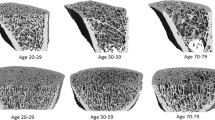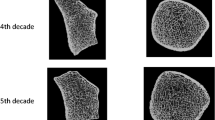Abstract
There have been few comprehensive studies on the age-related changes in bone mineral density (BMD) and bone structure in Chinese people. Using peripheral quantitative computed tomography (pQCT), we assessed volumetric BMD of both trabecular and cortical bone and their geometry at both radius and tibia in 620 Chinese men and 638 women, aged 20–98 years, in Hong Kong. Cortical BMD did not start declining until after the age of 50 years in women and the age of 60 years in men. In contrast, trabecular BMD declined with age starting from adulthood in both sexes, and the rates of decline accelerated after the age of 50 years only in women. The integral and trabecular bone area expanded with age in older men and women, primarily at the tibia. Cortical bone area decreased significantly in older women, particularly at the tibia, while it decreased only slightly with aging in men. The moment of inertia decreased with age at the radius in older men and women. At the tibia, age-related decline accelerated in older women, but not in older men. It was concluded that trabecularization of bone in response to declining BMD and mechanical loading may be maladaptive by reducing cortical bone area, if periosteal apposition cannot keep pace with it.


Similar content being viewed by others
References
Report of a WHO Scientific Group. WHO Technical Report Series No. 921
Genant HK, Jiang YB (2007) Perspectives on advances in bone imaging for osteoporosis. In: Qin L, Genant HK, Griffith J, Leung KS (eds) Advanced bioimaging technologies in assessment of quality of bone and scaffold biomaterials. Springer, Berlin, pp 5–26
Grampp S, Jergas M, Gluer CC, Lang P, Brastow P, Genant HK (1993) Radiologic diagnosis of osteoporosis. Current methods and perspectives. Radiol Clin North Am 31:1133–1145
Gluer CC, Jergas M, Hans D (1997) Peripheral measurement techniques for the assessment of osteoporosis. Semin Nucl Med 27:229–247
Qin L, Au SK, Chan KM, Lau MC, Woo J, Dambacher MA, Leung PC (2000) Peripheral volumetric bone mineral density in pre- and post-menopausal Chinese women in Hong Kong. Calcif Tissue Int 67:29–36
Qin L, Au SK, Leung PC, Lau MC, Woo J, Choy WY, Hung WY, Dambacher MA, Leung SK (2002) Baseline BMD and bone loss at distal radius measured by peripheral quantitative computed tomography in peri- and post-menopausal Hong Kong Chinese women. Osteoporos Int 13:962–970
Lau EM, Lee JK, Suriwongpaisal P, Saw SM, Das De S, Khir A, Sambrook P (2001) The incidence of hip fracture in four Asian countries: the Asian Osteoporosis Study (AOS). Osteoporos Int 12:239–243
Lau EM, Lynn H, Woo J, Melton LJ 3rd (2003) Areal and volumetric bone density in Hong Kong Chinese: a comparison with Caucasians living in the United States. Osteoporos Int 14:583–588
Wong YS, Woo J, Li CK, Li M, Yeung F, Lum CM, Chan WK, Choi TK (2008) Maximum oxygen uptake and body composition of healthy Hong Kong Chinese adult men and women ages 20–64. J Sports Sci 26:295–302
Kin CF, Shan WS, Shun LJ, Chung LP, Jean W (2007) Experience of famine and bone health in post-menopausal women. Int J Epidemiol 36:1143–1150
Lau EM, Leung PC, Kwok T, Woo J, Lynn H, Orwoll E, Cummings S, Cauley J (2006) The determinants of bone mineral density in Chinese men—results from Mr. Os (Hong Kong), the first cohort study on osteoporosis in Asian men. Osteoporos Int 17:297–303
Ferretti JL (2000) Peripheral quantitative computed tomography for evaluating structural and mechanical properties of small bone. In: An YH, Draughn RA (eds) Mechanical testing of bone and the bone–implant interface. CRC Press, Boca Raton
Ruff CB, Hayes WC (1982) Subperiosteal expansion and cortical remodelling of the human femur and tibia with aging. Science 217:945–948
Hormone supplement therapy (2006). http://www.union.org/new/tc_chi/health_info/health_articles_gyn1.htm. Assessed January 30, 2008
U.S. Department of Health and Human Services (2001) What is menopause. [Online exclusive]. Menopause: one woman’s story, every woman’s story. Retrieved January 30, 2008. http://www.niapublications.org/pubs/menopause/menopause.pdf
Kroger H, Lunt M, Reeve J, Dequeker J, Adams JE et al (1999) Bone density reduction in various measurement sites in men and women with osteoporotic fractures of spine and hip: the European Quantitation of Osteoporosis study. Calcif Tissue Int 64:191–199
Compare Regression Coefficients (n.d.). http://www.spsstools.net/Syntax/RegressionRepeatedMeasure/CompareRegressionCoefficients.txt. Accessed 24 April 2007
Russo CR, Lauretani F, Bandinelli S, Bartali B, Di Iorio A, Volpato S, Guralnik JM, Harris T, Ferrucci L (2003) Aging bone in men and women: beyond changes in bone mineral density. Osteoporos Int 14:531–538
Butz S, Wüster C, Scheidt-Nave C, Gotz M, Ziegler R (1994) Forearm BMD as measured by peripheral quantitative computed tomography (pQCT) in a German reference population. Osteoporos Int 4:179–184
Gatti D, Rossini M, Zamberlan N, Braga V, Fracassi E, Adami S (1996) Effect of aging on trabecular and compact bone components of proximal and ultradistal radius. Osteoporos Int 6:355–360
Faulkner RA, Bailey DA, Drinkwater DT, McKay HA, Arnold C, Wilkinson AA (1996) Bone densitometry in Canadian children 8–17 years of age. Calcif Tissue Int 59:344–351
Neu CM, Manz F, Rauch F, Merkel A, Schoenau E (2001) Bone densities and bone size at the distal radius in healthy children and adolescents: a study using peripheral quantitative computed tomography. Bone (NY) 28:227–232
Zanchetta JR, Plotkin H, Alvarez Filgueira ML (1995) Bone mass in children: normative values for the 2–20-year-old population. Bone (NY) 16:393S–399S
Dealing with Menopause (2006). http://www.fhs.gov.hk/textonly/english/health_info/class_life/woman/woman_wm_menopause_dm1.html
Wu FC, Tajar A, Pye SR, Silman AJ, Finn JD, O’Neill TW, Bartfai G, Casanueva F, Forti G, Giwercman A, Huhtaniemi IT, Kula K, Punab M, Boonen S, Vanderschueren D, European Male Aging Study Group (2008) Hypothalamic-pituitary-testicular axis disruptions in older men are differentially linked to age and modifiable risk factors: the European Male Aging Study. J Clin Endocrinol Metab 93:2737–2745
Smith EP, Boyd J, Frank GR, Takahashi H, Cohen RM, Specker B, Williams TC, Lubahn DB, Korach KS (1994) Estrogen resistance caused by a mutation in the estrogen-receptor gene in a man. N Engl J Med 331:1056–1061
Morishima A, Grumbach MM, Simpson ER, Fisher C, Qin K (1995) Aromatase deficiency in male and female siblings caused by a novel mutation and the physiological role of estrogens. J Clin Endocrinol Metab 80:3689–3698
Bilezikian JP, Morishima A, Bell J, Grumbach MM (1998) Increased bone mass as a result of estrogen therapy in a man with aromatase deficiency. N Engl J Med 339:599–603
Carani C, Qin K, Simoni M, Faustini-Fustini M, Serpente S, Boyd J, Korach KS, Simpson ER (1997) Effect of testosterone and estradiol in a man with aromatase deficiency. N Engl J Med 337:91–95
Riggs BL, Khosla S, Melton LJ 3rd (2002) Sex steroids and the construction and conservation of the adult skeleton. Endocr Rev 23:279–302
Orwoll ES (1996) Androgens as anabolic agents for bone. Trends Endocrinol Metab 7:77–84
Turner RT, Vandersteenhoven JJ, Bell NH (1987) The effects of ovariectomy and 17 beta-estradiol on cortical bone histomorphometry in growing rats. J Bone Miner Res 2:115–122
Frost HM (1999) On the estrogen–bone relationship and postmenopausal bone loss: a new model. J Bone Miner Res 14:1473–1477
Riggs BL, Khosla S, Melton LJ 3rd (1998) A unitary model for involutional osteoporosis: estrogen deficiency causes both type I and type II osteoporosis in postmenopausal women and contributes to bone loss in aging men. J Bone Miner Res 13:763–773
Ruff CB, Hayes WC (1988) Sex differences in age-related remodeling of the femur and tibia. J Orthop Res 6:886–896
Biggemann M, Hilweg D, Brinckmann P (1988) Prediction of the compressive strength of vertebral bodies of the lumbar spine by quantitative computed tomography. Skeletal Radiol 17:264–269
Brinkmann P, Biggemann M, Hilweg D (1989) Prediction of the compressive strength of human lumbar vertebrae. Spine 14:606–610
Mosekilde L (2000) Age-related changes in bone mass, structure, and strength-effects of loading. Z Rheumatol 59:I1–I9
Kaptoge S, Dalzell N, Folkerd E, Doody D, Khaw KT, Beck TJ, Loveridge N, Mawer eB, Berry JL, Shearer MJ, Dowsett M, Reeve J (2007) Sex hormone status may modulate rate of expansion of proximal femur diameter in older women alongside other skeletal regulators. J Clin Endocrinol Metab 92:304–313
Power J, Loveridge N, Lyon A, Rushton N, Parker M, Reeve J (2005) Osteoclastic cortical erosion as a determinant of subperiosteal osteoblastic bone formation in the femoral neck’s response to BMU imbalance. Effects of stance-related loading and hip fracture. Osteoporos Int 16:1049–1056
Kaptoge S, Dalzell N, Jakes RW, Wareham N, Day NE, Khaw KT, Beck TJ, Loveridge N, Reeve J (2003) Hip section modulus, a measure of bending resistance, is more strongly related to reported physical activity than BMD. Osteoporos Int 14:941–949
Jiang Y, Zhao J, Rosen C, Geusens P, Genant HK (1999) Perspectives on bone mechanical properties and adaptive response to mechanical challenge. J Clin Densitom 2:423–433
Martin RB, Burr DB (1989) Structure, function and adaptation of compact bone. Raven Press, New York
Woo J, Kwok T, Lau E, Li M, Yu LM (1998) Body composition in Chinese subjects: relationship with age and disease. Arch Gerontol Geriatr 26:23–32
Thomas GN, McGhee SM, Schooling M, Ho SY, Lam KS, Janus ED, Lam TH (2006) Impact of sex-specific body composition on cardiovascular risk factors: The Hong Kong Cardiovascular Risk Factor Study. Metabolism 55:563–569
Acknowledgments
The authors thank all participants dedicated to contributing to the study and The Chinese University of Hong Kong Jockey Club Centre for Osteoporosis Care and Control for supporting the study. Work was supported by National Institutes of Health R01 grant AR049439–01A1 and Research Grants Council Earmarked Grant CUHK4101/02 M.
Conflict of interest statement
The authors have no conflict of interest.
Author information
Authors and Affiliations
Corresponding author
About this article
Cite this article
Yuen, K.W.K., Kwok, T.C.Y., Qin, L. et al. Characteristics of age-related changes in bone compared between male and female reference Chinese populations in Hong Kong: a pQCT study. J Bone Miner Metab 28, 672–681 (2010). https://doi.org/10.1007/s00774-010-0170-7
Received:
Accepted:
Published:
Issue Date:
DOI: https://doi.org/10.1007/s00774-010-0170-7




